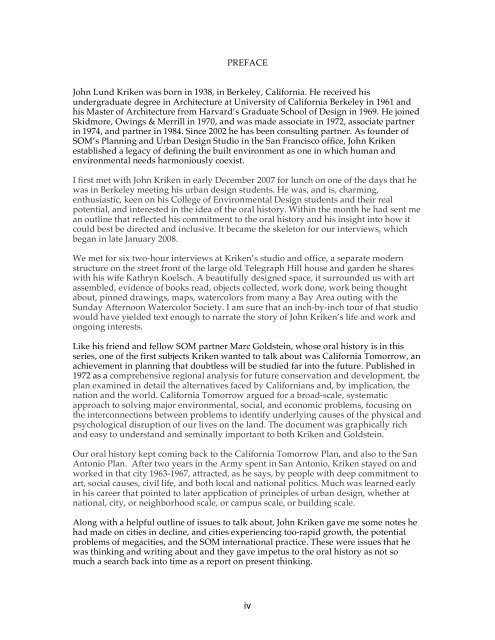ORAL HISTORY OF JOHN LUND KRIKEN Interviewed by Suzanne ...
ORAL HISTORY OF JOHN LUND KRIKEN Interviewed by Suzanne ...
ORAL HISTORY OF JOHN LUND KRIKEN Interviewed by Suzanne ...
Create successful ePaper yourself
Turn your PDF publications into a flip-book with our unique Google optimized e-Paper software.
PREFACE<br />
John Lund Kriken was born in 1938, in Berkeley, California. He received his<br />
undergraduate degree in Architecture at University of California Berkeley in 1961 and<br />
his Master of Architecture from Harvard’s Graduate School of Design in 1969. He joined<br />
Skidmore, Owings & Merrill in 1970, and was made associate in 1972, associate partner<br />
in 1974, and partner in 1984. Since 2002 he has been consulting partner. As founder of<br />
SOM’s Planning and Urban Design Studio in the San Francisco office, John Kriken<br />
established a legacy of defining the built environment as one in which human and<br />
environmental needs harmoniously coexist.<br />
I first met with John Kriken in early December 2007 for lunch on one of the days that he<br />
was in Berkeley meeting his urban design students. He was, and is, charming,<br />
enthusiastic, keen on his College of Environmental Design students and their real<br />
potential, and interested in the idea of the oral history. Within the month he had sent me<br />
an outline that reflected his commitment to the oral history and his insight into how it<br />
could best be directed and inclusive. It became the skeleton for our interviews, which<br />
began in late January 2008.<br />
We met for six two-hour interviews at Kriken’s studio and office, a separate modern<br />
structure on the street front of the large old Telegraph Hill house and garden he shares<br />
with his wife Kathryn Koelsch. A beautifully designed space, it surrounded us with art<br />
assembled, evidence of books read, objects collected, work done, work being thought<br />
about, pinned drawings, maps, watercolors from many a Bay Area outing with the<br />
Sunday Afternoon Watercolor Society. I am sure that an inch-<strong>by</strong>-inch tour of that studio<br />
would have yielded text enough to narrate the story of John Kriken’s life and work and<br />
ongoing interests.<br />
Like his friend and fellow SOM partner Marc Goldstein, whose oral history is in this<br />
series, one of the first subjects Kriken wanted to talk about was California Tomorrow, an<br />
achievement in planning that doubtless will be studied far into the future. Published in<br />
1972 as a comprehensive regional analysis for future conservation and development, the<br />
plan examined in detail the alternatives faced <strong>by</strong> Californians and, <strong>by</strong> implication, the<br />
nation and the world. California Tomorrow argued for a broad-scale, systematic<br />
approach to solving major environmental, social, and economic problems, focusing on<br />
the interconnections between problems to identify underlying causes of the physical and<br />
psychological disruption of our lives on the land. The document was graphically rich<br />
and easy to understand and seminally important to both Kriken and Goldstein.<br />
Our oral history kept coming back to the California Tomorrow Plan, and also to the San<br />
Antonio Plan. After two years in the Army spent in San Antonio, Kriken stayed on and<br />
worked in that city 1963-1967, attracted, as he says, <strong>by</strong> people with deep commitment to<br />
art, social causes, civil life, and both local and national politics. Much was learned early<br />
in his career that pointed to later application of principles of urban design, whether at<br />
national, city, or neighborhood scale, or campus scale, or building scale.<br />
Along with a helpful outline of issues to talk about, John Kriken gave me some notes he<br />
had made on cities in decline, and cities experiencing too-rapid growth, the potential<br />
problems of megacities, and the SOM international practice. These were issues that he<br />
was thinking and writing about and they gave impetus to the oral history as not so<br />
much a search back into time as a report on present thinking.<br />
iv



